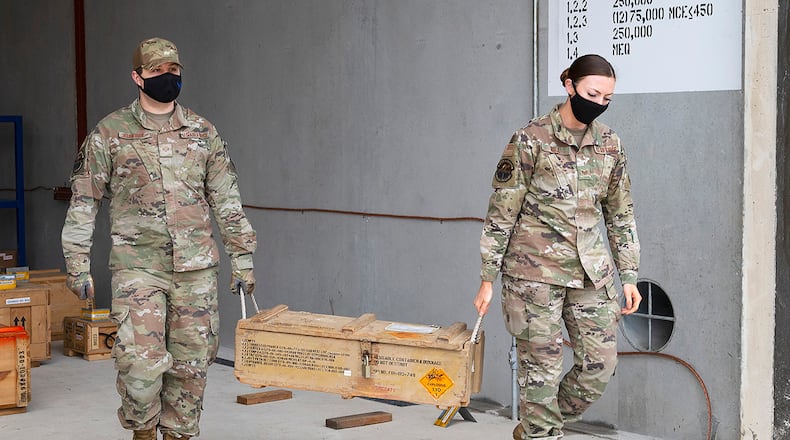“I’ve grown up in OSS my whole (military) life. I’m an airfield operations officer by trade,” Roley said. “This is literally the only location that I have ever known of where the ammo flight is part of the OSS function, which is pretty unique and pretty awesome.”
Awesome, but a bit scary.
“Oh, terrifying,” he added. “Because you train for decades for this job, for this responsibility, and then you hear that you have a function that is technically demanding, one that you don’t want to get wrong, and that you’re going to be responsible for.
“It’s terrifying initially, but then you get to meet the team. And you understand all you have to do is support them.”
The team consists of three civilian and 10 active-duty Airmen headed up by flight chief Steve Dennison, who said a lot of people on Wright-Patterson Air Force Base are not aware the Munitions Flight even exists.
“We hear that all the time,” he said. “They can’t even believe there’s one here on Wright-Patt, that we have a munition storage area. We store munitions on Wright-Patterson like almost every base in the Air Force.”
While there are no fighters or bombers assigned to Wright-Patterson AFB, Roley and Dennison say there is plenty of work to do and organizations for the 88 OSS Munitions Flight to support.
“One of the things that I found about ammo are all the agencies that you really don’t think about, that they support,” Roley said.
Examples include the base Honor Guard, Air Force Research Laboratory, National Air and S
pace Intelligence Center, the 788th Civil Engineer Squadron’s Explosive Ordnance Disposal Flight and 88th Security Forces Squadron – both the “Defenders” on the gate and K-9 unit.
The flight also supports other military organizations outside Wright-Patt.
“That’s part of their mission,” Roley said. “They are the only 24/7 (Department of Defense) facility within a five-state area that can handle the munitions.”
Its off-base partners include the Pennsylvania Air National Guard’s 171st Maintenance Group in Pittsburgh and units of the West Virginia National Guard. In the past, the flight also supported units in Michigan, Toledo and Fort Knox, Kentucky, according to Dennison.
Last year, 88 OSS took possession of newly constructed explosive igloos, a $6.5 million construction project. Dennison said they greatly increased the amount of munitions that can be stored and, yet, reduced the flight’s footprint.
“It increased the overall capability here at Wright-Patt by about 158%,” he said. “So that’s huge, and we reduced our overall footprint. These facilities are smaller, but they’re made better. So we’re extremely proud of the capability we give the installation for ammunition storage here.”
The job is more than just sticking a pallet of ammunition in an explosive igloo and leaving it there until someone needs it.
“Our role is to ship, store, inspect, receipt and account for all the munitions assets, which is quite a chore,” Dennison said. “All the way down to every last round is accounted for, all the way down to the blanks the Honor Guard uses.”
Tech. Sgt. Jonathan Bowers, NCO in charge of munitions inspection, stressed that safety is a priority at all times.
“Every time, before we do anything involving explosives, we have to get into the technical order and see the handling procedures,” he said. “We look up drop distances (and) any other safety precautions that are involved with that item. And then, obviously, we check out our vehicles, forklifts and make sure all of our equipment is serviceable.”
Two working fire extinguishers are required on every job, Bowers added. Every 15 months, personnel also have to take explosive safety training.
“Sometimes, it feels like it’s a lot, but we’re working with explosives,” he said. “We need to realize that, ‘Hey, this is dangerous!’ And we really can’t sleep on it and get complacent.”
Roley, meanwhile, says he’s far more confident about the squadron’s munitions mission than when he took charge of 88 OSS this past summer.
“They’re going to get the job done,” he said. “So the stress level is a lot less now that I’ve been in the seat for a little bit, not because I know more about ammo, but because I know more about the team.”
About the Author



